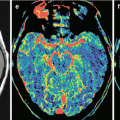, Valery Kornienko2 and Igor Pronin2
(1)
N.N. Blockhin Russian Cancer Research Center, Moscow, Russia
(2)
N.N. Burdenko National Scientific and Practical Center for Neurosurgery, Moscow, Russia
From the standpoint of radiology, the brain is a unique organ, whose substance enclosed in a rather thin bone “shell” could be differentiated as gray and white matter due to its relative homogeneity and immobility as early as on images obtained using the first models of CT scanners. Subsequently, imaging techniques, particularly MRI, allowed for a more accurate visualization of cerebral structural features and better identification of pathological changes in the brain structure than with CT. Requirements of clinicians for quantitative and most importantly qualitative content of the obtained diagnostic findings are constantly growing. In terms of diagnostic requests of modern medicine, a mere statement of the fact of visualization of a focal brain lesion is definitely not enough in most cases. The actual clinical situation is such that a formal description of syntopical features of focal brain lesions is the distant past of continuously developing neuroimaging methods. Today, there is a demand for technology allowing to obtain information that brings findings of noninvasive radiation diagnostic methods as close as possible to the exact interpretation of the histologic nature of lesions, an objective assessment of the characteristics of their blood supply, etc., without any techniques with traumatic access to abnormal sites.
In neuroimaging, a differential diagnostic series in focal brain lesions includes primary tumors, metastases of tumors from other sites, and ischemia. It is important to remember that an X-ray pattern in metastatic brain lesions is characterized by a variety of manifestations and dynamic development of secondary tumors, which is essential for the interpretation of diagnostic evidence in patients without history of tumors. The right selection of treatment tactics for such patients directly depends on the reliability of neuroradiological findings that should indicate the secondary nature of intracranial neoplasms as accurately as possible.
This monograph is based on the analysis of clinical cases of more than 3000 patients with metastatic brain lesions, including the steps of the primary and differential diagnosis, as well as various stages of treatment at the N.N. Blokhin Russian Cancer Research Center and N.N. Burdenko Research Institute of Neurosurgery. We did our best to highlight the ways of solving the main problems related to both the issues of primary and differential diagnosis (including modern methods of determining a true site of primary tumor and the disease extent in general), as well as some aspects of diagnosis of treatment-induced changes in the brain tissue, developing after surgery, radiotherapy, and antitumor drug treatment, involving capabilities of the entire range of modern diagnostic methods (computed, magnetic resonance, and positron emission tomography).
A metastasis (from the Greek μετάστασις, “transference, removal, change”) is a distant secondary focus of a pathological process caused by the transfer of its origin (tumor cells, microorganisms) from the primary site through the body tissues. In the modern sense, a metastasis usually characterizes local spread of cancer cells (Encyclopedia).
The fact that malignant tumors can metastasize into the brain has long been known; however, such metastases used to be identified very rarely; therefore, the treatment of such patients was associated with considerable difficulties. In 1888, Cowers divided intracranial lesions by their frequency into six categories, with metastatic carcinoma being on the third place by its frequency. Also in 1888, Bramwell noted that brain metastases could originate from any organ system but in particular from the lungs and that the latter, in turn, were a certain “filter” for metastases of tumors from other sites. In 1889, Paget proposed the theory of metastasizing, according to which the brain substance was presented as a great culture medium for foreign organisms. He suggested that metastasizing was not a spontaneous process but occurred only in cases where there was a specific interaction between the migrating tumor cells and a recipient organ—the seed and soil hypothesis.
Further study of the issue did not result in any significant advances, and many tumors described as carcinoma actually had a metastatic nature. Only in 1927, Globus and Selinsky published their paper that described clinical and pathological manifestations of the disease in 12 patients with brain metastases, and already in 1933, a symptomatic classification was developed based on clinical manifestations of brain metastases that may differ from other manifestations of intracranial tumors. This classification became the first differential diagnostic algorithm for brain neoplasms. From that moment on, approaches to the treatment of secondary tumors in the brain began to differ from those generally accepted.
The quantitative criterion gives particular relevance to the issue of metastatic brain lesions: it is a fair assumption to say that patients with metastatic brain tumors already make up more than half of the entire cohort of neuro-oncological patients. The majority of patients receive a complex therapy with an emphasis on radiosurgical treatment. As such, surgical removal of metastatic brain tumors becomes a more and more rare treatment strategy and is performed either for solitary lesions or after failure of other methods of cancer treatment. The key point in deciding on the tactics of treatment becomes criteria of patient’s objective status, the presence and extent of metastatic involvement of other organs. For this reason, patients with metastatic brain lesions cannot be regarded solely as neuro-oncological patients: the extent of neoplastic lesions in the body and foci of metastatic lesions, whose manifestations are dominant in the clinical picture of the disease, should be taken into account.
According to Langer and Mehta (2005), the number of new cases of metastatic brain lesions in malignant tumors identified in the USA each year is more than 170,000, and, according to Smedby et al. (2009), it tends to increase. Analyzing the statistics of the incidence of malignant tumors in Russia and taking into account average results of cooperative studies on the incidence of cerebral metastases, it can be assumed that it is actually 70,000 persons a year. A number of factors may contribute to an increased incidence of cerebral metastases, including introduction of high-tech neuroimaging techniques and increased life expectancy of cancer patients. Based on WHO prognoses, the number of cancer cases will continue to grow from 14 million in 2012 to 22 million in the next decade.
According to the international project GLOBOCAN 2012 of the WHO International Agency for Research on Cancer (IARC), including statistics from 184 countries around the world, the most frequent carcinomas in the male population are as follows: lung cancer (16.7% of all cancers), prostate cancer (15.0%), colorectal cancer (10.0%), gastric cancer (8.5%), and liver cancer (7.5%). At the same time, mortality among men is 23.6% from lung cancer, 11.2% from liver cancer, and 10.1% from stomach cancer. Lung cancer in the male population has the highest incidence rate—34.2 per 100,000—and the highest mortality rate, 30.0 per 100,000 persons. The incidence rate of prostate cancer that occupies the second place among all cancers is 31.1 per 100,000 persons, but its mortality is significantly lower—7.8 per 100,000 compared to lung cancer. In the women’s population, breast cancer has the highest incidence (25.2%). It is followed by colorectal cancer (9.2%), lung cancer (8.7%), cervical cancer (7.9%), and stomach cancer (4.8%). Note that the mortality from breast cancer has decreased to 14.7% as compared to 2011 and mortality from lung cancer in women accounts for 13.8%.
Taking into account both sexes, according to GLOBOCAN 2012, the most prevalent are lung cancer (13.0%), breast cancer (11.9%), colorectal cancer (9.7%), prostate cancer (7.9%), and gastric cancer (6.8%). The incidence of cancer increases dramatically with age. Thus, the incidence of cancer in the pediatric population (0–14 years of age) is 10 per 100,000; it becomes 150 per 100,000 by 40–44 years of age and more than 500 per 100,000 by 60–64 years of age (GLOBOCAN 2012).
The highest cancer rates are reported in industrialized countries of North America, Western Europe, as well as in Japan, the Republic of Korea, Australia, and New Zealand. Medium incidence is observed in Central and South America, East European countries, and Southeast Asian countries, including China. The lowest rate is reported in Africa and in western and southern parts of Asia, including India. In the industrialized countries of Europe, in the USA, and in Canada, the prevalent cancers are prostate cancer, breast cancer , lung cancer, and colorectal cancer. In Eastern and Central Asia with the most densely populated regions (57% of the global population, including 19% for China, 18% for India), lung cancer and gastrointestinal carcinoma are most commonly identified in the male population. In female population from these regions, breast cancer, lung cancer, cervical cancer , colorectal cancer, and gastric cancer prevail. Table 1.1 shows the statistical data on cancer incidence in the world population and in Russia, according to the WHO for 2012 (GLOBOCAN 2012).
Table 1.1
Cancer statistics in Russia and worldwide (WHO 2012)
Primary site | RF/total | Incidence | Morbidity | |||
|---|---|---|---|---|---|---|
Abs. | (%) | ASR(W) | Abs. | % | ||
Lungs | RF | 55,805 | 12.2 | 24.0 | 5,450,888 | 17.2 |
Total | 1,824,701 | 13.0 | 23.1 | 1,589,925 | 19.4 | |
Breast | RF | 57,502 | 12.5 | 45.6 | 24,544 | 8.3 |
Total | 1,671,149 | 11.9 | 43.1 | 521,907 | 6.4 | |
Melanoma | RF | 8717 | 1.9 | 4.1 | 3632 | 1.2 |
Total | 232,130 | 1.7 | 3.0 | 55,488 | 0.7 | |
Colorectal | RF | 59,928 | 13.1 | 24.5 | 39,907 | 13.5 |
Total | 1,360,602 | 9.7 | 17.2 | 693,933 | 8.5 | |
Kidneys | RF | 19,313 | 4.2 | 8.9 | 9025 | 3.1 |
Total | 337,860 | 2.4 | 4.4 | 143,406 | 1.7 | |
Stomach | RF | 38,417 | 8.4 | 16.0 | 32,854 | 11.1 |
Total | 951,594 | 6.8 | 12.1 | 723,073 | 8.8 | |
Esophagus | RF | 7263 | 1.6 | 3.1 | 6499 | 2.2 |
Total | 455,784 | 3.2 | 5.9 | 400,169 | 4.9 | |
Pancreas | RF | 14,512 | 3.2 | 6.0 | 16,371 | 5.5 |
Total | 337,872 | 2.4 | 4.2 | 330,391 | 4.0 | |
Cervix | RF | 15,342 | 3.3 | 15.3 | 7371 | 2.5 |
Total | 527,624 | 3.8 | 14.0 | 265,672 | 3.2 | |
Uterine body | RF | 20,972 | 4.6 | 16.1 | 5477 | 1.9 |
Total | 319,605 | 2.3 | 8.3 | 76,160 | 0.9 | |
Ovaries | RF | 13,373 | 2.9 | 11.3 | 7971 | 2.7 |
Total | 238,719 | 1.7 | 6.1 | 151,917 | 1.9 | |
Prostate | RF | 26,885 | 5.9 | 30.1 | 11,480 | 3.9 |
Total | 1,094,916 | 7.8 | 30.7 | 307,481 | 3.7 | |
Testicles | RF | 1330 | 0.3 | 1.8 | 399 | 0.1 |
Total | 55,266 | 0.4 | 1.5 | 10,351 | 0.1 | |
Thyroid | RF | 10,174 | 2.2 | 5.2 | 2020 | 0.7 |
Total | 298,102 | 2.1 | 4.0 | 39,771 | 0.5 | |
Liver | RF | 6812 | 1.5 | 2.9 | 8521 | 2.9 |
Total | 782,451 | 5.6 | 10.1 | 745,533 | 9.1 | |
Gallbladder | RF | 3411 | 0.7 | 1.3 | 2834 | 1.0 |
Total | 178,101 | 1.3 | 2.2 | 142,823 | 1.7 | |
Larynx | RF | 6421 | 1.4 | 2.9 | 4309 | 1.5 |
Total | 156,877 | 1.1 | 2.1 | 83,376 | 1.0 | |
Bladder | RF | 13,853 | 3.0 | 5.7 | 6843 | 2.3 |
Total | 429,793 | 3.1 | 5.3 | 165,084 | 2.0 | |
Other | RF | 78,352 | 17.1 | – | 54,352 | 18.4 |
Total | 2,814,748 | 19.7 | – | 1,755,115 | 21.5 | |
All cancers | RF | 458,382 | 100.0 | 204.3 | 295,357 | 100.0 |
Total | 14,067,894 | 100.0 | 182.0 | 8,201,575 | 100.0 | |
The risk of malignant tumor metastasizing increases with the age of patients. Thus, according to Walker et al. (1985), one case of metastasizing per 100,000 is detected in individuals younger than 35 years of age, and 30 cases per 100,000 are detected in persons over 60 years of age. Brain metastases are often identified in elderly patients. Thus, according to Raizer et al. (2007), up to 60% of metastatic brain lesions are detected in patients aged 50–70 years of age, which correlates with the highest incidence of malignant neoplasms; 70% of deaths from cancer in the USA are reported in patients older than 65 years of age (Yancik and Ries 2004). However, several authors point out that there is a higher risk of brain metastases in young patients with carcinoma with any site than in older patients, which indicates a more aggressive course of the disease (Graus et al. 1986; Tasdemiroglu and Patchell 1997; Schouten et al. 2002; Pronin et al. 2005).
Brain metastases in children occur in 4–13% (Vannucci and Baten 1974; Graus et al. 1983; Posner 1995; Tasdemiroglu and Patchell 1997; Paulino et al. 2003; Kebudi et al. 2005; Yoshida 2007; Salvati et al. 2010). The average time of MTS development after the identification of the primary tumor is 327 days. The most common tumors in children under 15 years of age are lymphoma, osteosarcoma, rhabdomyosarcoma, and Ewing’s sarcoma (Graus et al. 1983). Embryonal tumors typically metastasize in patients aged 15–22 years. Rhabdomyosarcoma metastasizes more frequently than Ewing’s sarcoma. According to Rodriguez-Galindo et al. (1997), melanoma metastases in the brain developed in 18% of cases (analysis of 44 pediatric cases).
Brain metastases are the most common tumor-related abnormality in the central nervous system and the most common intracranial tumor lesion that surpasses the number of primary brain tumors by several times. An autopsy identifies brain metastases in 20–40% of patients with metastatic cancers.
Walker et al. (1985) reported that the risk of brain metastases from malignant tumors is higher in males than in females (9.7 and 7.1 per 100,000, respectively). Lung cancer most often metastasizes in men (6.1 and 2.2 per 100,000, respectively), while in women, breast cancer metastasizes most often. However, one recent study by Nieder et al. (2010) that analyzed the changes in the epidemiology of brain metastases within the last two decades revealed the prevalence of the female population. The authors attribute this fact to an increase in the lung cancer incidence among women lately.
Based on the results of numerous studies on the diagnosis and treatment of brain metastases, we can confidently say that lung cancer is the most common cause of secondary tumor brain lesions (Baker et al. 1951; Nugent et al. 1979; Emami and Graham 1997; Andre et al. 2004; Smedby et al. 2009; Nieder et al. 2010).
Frequency of brain metastases by primary tumor site is provided in Table 1.2.
Table 1.2
Frequency of brain metastases of malignant tumors with various sites (according to Nussbaum et al. 1996)
Primary tumor site | Frequency of metastasizing (%) | Single metastases (%) | Multiple metastases (%) |
|---|---|---|---|
Lung | 40 | 48 | 52 |
Breast
Stay updated, free articles. Join our Telegram channel
Full access? Get Clinical Tree
 Get Clinical Tree app for offline access
Get Clinical Tree app for offline access

|





